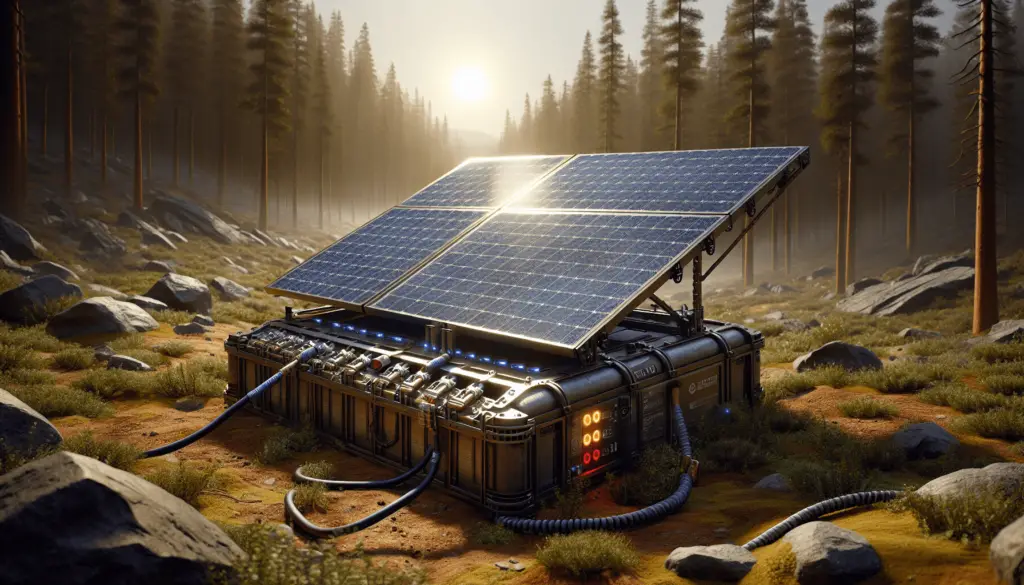Have you ever wondered how you can ensure a reliable source of energy during emergencies or off-grid living situations? In this article, we will explore practical and efficient renewable energy storage solutions from a prepper’s perspective. Whether you are preparing for a natural disaster or simply looking to live a more self-sufficient lifestyle, these tips and strategies will help you harness the power of renewable energy to meet your needs.

Importance of Renewable Energy Storage Solutions
When it comes to sustainable living and emergency preparedness, having a reliable energy source is crucial. Renewable energy sources such as solar, wind, and hydro power can provide a clean and sustainable alternative to traditional fossil fuels. However, these energy sources can be intermittent, making energy storage essential for ensuring a continuous power supply. By investing in renewable energy storage solutions, you can store excess energy generated during peak production times and use it when needed, even when the sun isn’t shining or the wind isn’t blowing.
Why You Need Renewable Energy Storage Solutions
Having renewable energy storage solutions in place allows you to maximize the benefits of renewable energy sources. It enables you to store excess energy for later use, reducing reliance on the grid and saving money in the long run. By utilizing renewable energy storage solutions, you can increase your energy independence, reduce your carbon footprint, and have peace of mind knowing that you have a reliable power supply during emergencies.
Types of Renewable Energy Storage Solutions
There are various types of renewable energy storage solutions available, each with its own advantages and challenges. From battery storage systems to pumped hydro storage, each technology offers unique benefits for storing and utilizing renewable energy. Let’s explore some of the most common renewable energy storage solutions used by preppers and off-grid enthusiasts.
Battery Storage Systems
Battery storage systems are one of the most popular renewable energy storage solutions due to their versatility and scalability. These systems store excess energy generated by solar panels or wind turbines in rechargeable batteries, allowing you to use stored energy when needed. Lithium-ion batteries are commonly used for residential and commercial energy storage applications due to their high energy density, long lifespan, and fast-charging capabilities.
Pumped Hydro Storage
Pumped hydro storage is a form of energy storage that uses gravitational potential energy to store and generate electricity. This technology involves pumping water from a lower reservoir to a higher reservoir during periods of low energy demand, and releasing it back down through turbines to generate electricity during peak demand. Pumped hydro storage systems are highly efficient and can store large amounts of energy for long periods, making them an ideal solution for grid-level energy storage.
Flywheel Energy Storage
Flywheel energy storage systems store kinetic energy in a rotating mass, which can be released as electricity when needed. These systems use high-speed flywheels to store energy and can provide quick bursts of power for short durations. Flywheel energy storage is ideal for applications that require rapid response times and short-duration energy storage, such as stabilizing electrical grids and supporting renewable energy sources.
Thermal Energy Storage
Thermal energy storage systems store heat or cold energy for later use in heating or cooling applications. These systems can store excess thermal energy generated by solar collectors or other renewable energy sources and release it when needed to provide heating, cooling, or hot water. Thermal energy storage is a cost-effective and efficient way to store and utilize renewable energy for residential and commercial buildings.
Compressed Air Energy Storage
Compressed air energy storage systems store energy by compressing air into underground caverns or pressurized containers, which can be released to generate electricity as needed. This technology is well-suited for grid-level energy storage and can provide large-scale energy storage capacity at a relatively low cost. Compressed air energy storage systems are environmentally friendly and can help balance supply and demand on the grid.
Factors to Consider When Choosing Renewable Energy Storage Solutions
When selecting renewable energy storage solutions for your home or property, there are several factors to consider to ensure you choose the right technology for your needs. Consider the following factors when evaluating renewable energy storage options:
Energy Storage Capacity
The energy storage capacity of a system determines how much energy it can store and deliver when needed. Consider your daily energy consumption and peak energy demand to determine the appropriate storage capacity for your needs. Larger storage capacity systems are suitable for properties with high energy demand, while smaller systems may be sufficient for residential applications.
Efficiency and Round-Trip Efficiency
The efficiency of an energy storage system determines how much energy is lost during the storage and retrieval process. High-efficiency systems can store and deliver energy with minimal losses, maximizing the overall efficiency of your renewable energy system. Round-trip efficiency measures the total energy output compared to the total energy input, providing a more accurate assessment of the system’s performance.
Cost and Return on Investment
The cost of renewable energy storage solutions can vary depending on the technology, capacity, and installation requirements. Consider the upfront costs, ongoing maintenance expenses, and potential savings from reduced energy bills when calculating the return on investment for a storage system. Evaluate the payback period and long-term cost savings to determine the economic feasibility of implementing renewable energy storage solutions.
Scalability and Flexibility
Choose renewable energy storage solutions that are scalable and flexible to accommodate future energy needs and system expansions. Consider technologies that can be easily upgraded or expanded to meet increasing energy demands or changes in energy consumption patterns. Scalable storage solutions allow you to adjust the storage capacity as needed without requiring a complete system overhaul.
Durability and Longevity
Invest in renewable energy storage solutions that are durable, reliable, and have a long lifespan to ensure a consistent power supply for years to come. Choose high-quality components and reputable manufacturers to minimize the risk of system failures or malfunctions. Consider the warranty and maintenance requirements of the storage system to ensure it will remain operational and efficient over its expected lifespan.
Tips for Implementing Renewable Energy Storage Solutions
Whether you are new to renewable energy or an experienced prepper looking to upgrade your energy storage system, there are several tips to keep in mind when implementing renewable energy storage solutions. Follow these guidelines to optimize the performance and efficiency of your energy storage system:
Conduct a Site Assessment
Before installing renewable energy storage solutions, conduct a thorough site assessment to evaluate the sun exposure, wind patterns, water availability, and other environmental factors that may impact energy production and storage. Consider the location, orientation, and shading of solar panels, wind turbines, or other renewable energy sources to maximize energy generation and storage capacity.
Determine Your Energy Needs
Calculate your daily energy consumption, peak energy demand, and backup power requirements to determine the appropriate energy storage capacity for your needs. Consider your lifestyle, appliances, and electrical devices to estimate the amount of energy you need to store and use during emergencies or off-grid living situations. Size your energy storage system accordingly to ensure a reliable power supply at all times.
Integrate Energy Management Systems
Integrate energy management systems and smart technologies to optimize the performance and efficiency of your renewable energy storage solutions. Use energy monitoring tools, battery management systems, and other software applications to track energy production, consumption, and storage in real time. Implement energy-saving strategies, load-shifting techniques, and demand-response programs to maximize the benefits of your energy storage system.
Maintain and Monitor Your Energy Storage System
Regularly maintain and monitor your renewable energy storage system to ensure optimal performance and longevity. Follow manufacturer recommendations for battery maintenance, system inspections, and preventive maintenance to prevent system failures and maximize energy storage capacity. Monitor energy production, storage levels, and consumption patterns to identify inefficiencies or malfunctions and address them promptly.
Backup Your Energy Storage System
Plan for contingencies and emergencies by implementing backup solutions for your energy storage system. Install backup generators, fuel reserves, or grid tie-in capabilities to ensure a continuous power supply during extended outages or unforeseen events. Consider alternative energy sources, energy storage technologies, and off-grid solutions to prepare for worst-case scenarios and ensure energy resilience.
Seek Professional Advice and Assistance
Consult with renewable energy experts, energy consultants, and qualified contractors to design, install, and maintain your energy storage system. Seek professional advice on system sizing, equipment selection, permitting requirements, and safety standards to ensure a successful and compliant installation. Work with reputable suppliers and experienced professionals to maximize the performance and reliability of your renewable energy storage solutions.

Conclusion
Renewable energy storage solutions are essential for preppers, off-grid enthusiasts, and environmentally conscious individuals looking to harness the power of renewable energy. By investing in energy storage technologies such as battery storage systems, pumped hydro storage, flywheel energy storage, thermal energy storage, and compressed air energy storage, you can ensure a reliable and sustainable power supply for your home or property. Consider the factors mentioned in this article when choosing renewable energy storage solutions, and follow the tips for implementing and optimizing your energy storage system. With the right approach and strategy, you can achieve energy independence, reduce your carbon footprint, and be prepared for any energy-related challenges that may arise. Start planning and implementing your renewable energy storage solutions today to secure a clean, reliable, and sustainable energy future for yourself and future generations.
